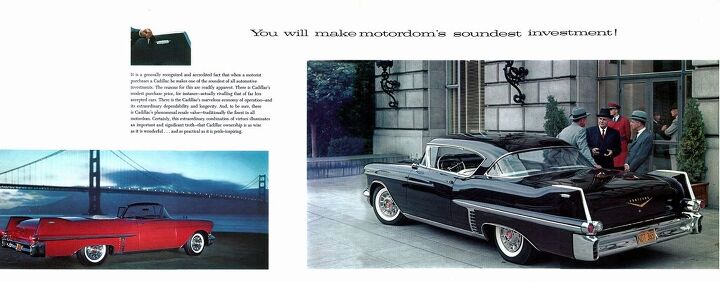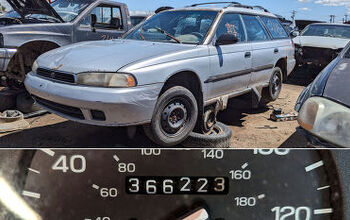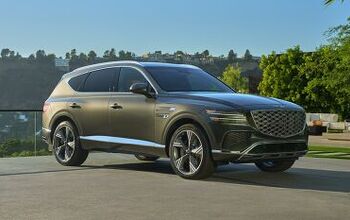Rare Rides Icons: The Cadillac Eldorado, Distinctly Luxurious (Part XIII)

As we learned in our last installment, the Cadillac lineup was revised visually for 1957, and would be revised again in 1958 once quad headlamps became legal. Fins grew, hoods smoothed, roofs leaned backward, and there were more Eldorado variants than ever before. But styling and lineup changes weren’t the only new features in 1957: Cadillac was also eager to tout its Standard of the World engineering, safety, and engine advancements!
The new Sixty-Two of 1957 was again the basis for the standard Eldorado, with the all-new Eldorado Brougham based on the Series 70 four-door platform. Sixty-Two continued on the C-body as it had in its fourth generation. As mentioned previously, the new 1957 C-body saw a half-inch increase in wheelbase, to 129.5 inches.
That slight stretch was accompanied by a new chassis design, as the C-body (and all Cadillacs in 1957) adopted a tubular X-frame setup. Notably, the new design lacked side rails. Cadillac claimed this change allowed for a lower body height while maintaining the same space inside the cabin, and provided increased torsional strength.
The height claim was true, as the Eldorado and Sixty-Two saw overall height decrease from 62 inches in 1956 to 59.1 inches in 1957. Remember that for decades a longer, lower, and wider look was the aim of the domestic manufacturers. But the frame design wasn’t the only update for the brand, as there was quite a list.
Other advancements across the lineup included a new front suspension with a spherical joint design. Rear springs were relocated slightly for better handling and stability. The track front and rear was newly uniform, at 61 inches.
The rear axle of the C-body was upgraded in 1957 with a new, heavier-duty housing and larger bearings. The differential’s gear tooth angle was new, and promised more quiet operation. The braking system received a new power unit, and the emergency brake was activated and released via a pedal on the floor (previously a hand-activated pull bar). Driving refinements continued with a new coupling for the Hydra-Matic four-speed automatic.
All Cadillacs breathed easier via a new dual exhaust in 1957. The company’s engine was thoroughly updated that year, and the edits meant the 365 cubic inch (6.0L) OHV V8 produced 300 horsepower as standard, up from 285 the prior year. Worth mentioning, the old 331 cubic inch (5.4L) V8 from 1956 that dated back to 1949 was discontinued.
While 300 was the new base horsepower figure, Eldorado Biarritz and Seville offered an upgraded carburetor for 325 horses. Extra power was supposedly exclusive to Biarritz and Seville, though modern sources indicate extra power was available on any model. The 365 V8 also featured larger combustion chambers, a better piston design, and a revised 10:1 compression ratio.
Other engine changes included a new lower carb with larger secondary barrels, a new air cleaner, and larger intake valves. There was also a new intake manifold, exhaust manifold, a higher output alternator, a larger radiator, starter motor, and finally a new location for the battery so it didn’t get so hot. Though all the engineering changes were baked into every model across the lineup, there were also revisions to the optional equipment list.
All cars used a revised heating system that was more effective, and there was a new radio design. There was an automatic trunk release button too. And that most luxurious of features, air conditioning, featured a new design on Sixty Special and 62, with a new rear-mounted design on Series 75. Cars were coming to the end of the era where heating was an optional extra.
There were a bevy of new interior details in 1957, with a padded instrument cover, new knobs, courtesy lights, steering wheel, and revised placement of window switches. Front seats in all models also offered a greater level of adjustment. Styling was revised throughout the cabin, with new upholstery materials, door panel design, and instrument panel layout. Even the sun visors were new, as they locked into place and were full-width with the windshield.
But those features didn’t get much attention, as the general public almost immediately reacted to one specific engineering choice again and again: the tubular X-frame. It appeared on Cadillac (as expected) first in 1957, then spread to Chevrolet and Pontiac in 1958. Engineers knew the tube design had better rigidity than a traditional, rectangular ladder frame.
GM called it the Safety Girder system. The rocker panels, cowl, and body crossmembers were reinforced into an integrated and semi-unitized frame. All parts worked together to reinforce the car structurally and make it safer, with no frame rails needed.
The public focused on that last part, the lack of frame rails. Without them, general consensus was that there was almost no protection in the event of a side impact. There was no crash testing at the time as such, so there was no way to say one way or the other.
But what did happen were many crashes where people died at the wheel of an X-frame GM car. The company was sued over the safety of the X-frame in 1961, in Evans v. General Motors Corporation. The lawsuit came after the driver of a 1961 Chevy wagon was killed in an accident. GM didn’t win the case, but they didn’t really lose either.
The court did not rule whether the X-frame was safe, but stated a manufacturer had no legal obligation to make its vehicles either “accident proof or fool-proof.” GM walked away with carte blanche on safety and continued building X-frame cars. Regulation didn’t change until the NHTSA Safety Act of 1966. That legislation set an expectation: Automakers had to exercise a reasonable level of care for passenger safety in their designs.
Each GM brand went their own way with the X-frame (funny, that brand independence). Cadillac and Chevrolet would use the X-frame through 1964, while Pontiac used it only from 1958 to 1960. Oldsmobile was wisest of the group, as its engineers opted never to produce an X-frame vehicle. Buick opted into X-frame later, and used it on full-size models from 1961 to 1964, and kept it in use on Riviera through 1970.
Other manufacturers of the time stated their traditional perimeter frames were safer, and GM’s foray into the X-frame proved the only domestic example ever to occur. We’ll pick up next time with a review of the Eldorado’s new exterior styling for 1957.
[Images: GM]
Become a TTAC insider. Get the latest news, features, TTAC takes, and everything else that gets to the truth about cars first by subscribing to our newsletter.

Interested in lots of cars and their various historical contexts. Started writing articles for TTAC in late 2016, when my first posts were QOTDs. From there I started a few new series like Rare Rides, Buy/Drive/Burn, Abandoned History, and most recently Rare Rides Icons. Operating from a home base in Cincinnati, Ohio, a relative auto journalist dead zone. Many of my articles are prompted by something I'll see on social media that sparks my interest and causes me to research. Finding articles and information from the early days of the internet and beyond that covers the little details lost to time: trim packages, color and wheel choices, interior fabrics. Beyond those, I'm fascinated by automotive industry experiments, both failures and successes. Lately I've taken an interest in AI, and generating "what if" type images for car models long dead. Reincarnating a modern Toyota Paseo, Lincoln Mark IX, or Isuzu Trooper through a text prompt is fun. Fun to post them on Twitter too, and watch people overreact. To that end, the social media I use most is Twitter, @CoreyLewis86. I also contribute pieces for Forbes Wheels and Forbes Home.
More by Corey Lewis
Latest Car Reviews
Read moreLatest Product Reviews
Read moreRecent Comments
- Bd2 Lexus is just a higher trim package Toyota. ^^
- Tassos ONLY consider CIvics or Corollas, in their segment. NO DAMNED Hyundais, Kias, Nissans or esp Mitsus. Not even a Pretend-BMW Mazda. They may look cute but they SUCK.I always recommend Corollas to friends of mine who are not auto enthusiasts, even tho I never owed one, and owned a Civic Hatch 5 speed 1992 for 25 years. MANY follow my advice and are VERY happy. ALmost all are women.friends who believe they are auto enthusiasts would not listen to me anyway, and would never buy a Toyota. They are damned fools, on both counts.
- Tassos since Oct 2016 I drive a 2007 E320 Bluetec and since April 2017 also a 2008 E320 Bluetec.Now I am in my summer palace deep in the Eurozone until end October and drive the 2008.Changing the considerable oils (10 quarts synthetic) twice cost me 80 and 70 euros. Same changes in the US on the 2007 cost me $219 at the dealers and $120 at Firestone.Changing the air filter cost 30 Euros, with labor, and there are two such filters (engine and cabin), and changing the fuel filter only 50 euros, while in the US they asked for... $400. You can safely bet I declined and told them what to do with their gold-plated filter. And when I changed it in Europe, I looked at the old one and it was clean as a whistle.A set of Continentals tires, installed etc, 300 EurosI can't remember anything else for the 2008. For the 2007, a brand new set of manual rec'd tires at Discount Tire with free rotations for life used up the $500 allowance the dealer gave me when I bought it (tires only had 5000 miles left on them then)So, as you can see, I spent less than even if I owned a Lexus instead, and probably less than all these poor devils here that brag about their alleged low cost Datsun-Mitsus and Hyundai-Kias.And that's THETRUTHABOUTCARS. My Cars,
- NJRide These are the Q1 Luxury division salesAudi 44,226Acura 30,373BMW 84,475Genesis 14,777Mercedes 66,000Lexus 78,471Infiniti 13,904Volvo 30,000*Tesla (maybe not luxury but relevant): 125,000?Lincoln 24,894Cadillac 35,451So Cadillac is now stuck as a second-tier player with names like Volvo. Even German 3rd wheel Audi is outselling them. Where to gain sales?Surprisingly a decline of Tesla could boost Cadillac EVs. Tesla sort of is now in the old Buick-Mercury upper middle of the market. If lets say the market stays the same, but another 15-20% leave Tesla I could see some going for a Caddy EV or hybrid, but is the division ready to meet them?In terms of the mainstream luxury brands, Lexus is probably a better benchmark than BMW. Lexus is basically doing a modern interpretation of what Cadillac/upscale Olds/Buick used to completely dominate. But Lexus' only downfall is the lack of emotion, something Cadillac at least used to be good at. The Escalade still has far more styling and brand ID than most of Lexus. So match Lexus' quality but out-do them on comfort and styling. Yes a lot of Lexus buyers may be Toyota or import loyal but there are a lot who are former GM buyers who would "come home" for a better product.In fact, that by and large is the Big 3's problem. In the 80s and 90s they would try to win back "import intenders" and this at least slowed the market share erosion. I feel like around 2000 they gave this up and resorted to a ton of gimmicks before the bankruptcies. So they have dropped from 66% to 37% of the market in a quarter century. Sure they have scaled down their presence and for the last 14 years preserved profit. But in the largest, most prosperous market in the world they are not leading. I mean who would think the Koreans could take almost 10% of the market? But they did because they built and structured products people wanted. (I also think the excess reliance on overseas assembly by the Big 3 hurts them vs more import brands building in US). But the domestics should really be at 60% of their home market and the fact that they are not speaks volumes. Cadillac should not be losing 2-1 to Lexus and BMW.
- Tassos Not my favorite Eldorados. Too much cowbell (fins), the gauges look poor for such an expensive car, the interior has too many shiny bits but does not scream "flagship luxury", and the white on red leather or whatever is rather loud for this car, while it might work in a Corvette. But do not despair, a couple more years and the exterior designs (at least) will sober up, the cowbells will be more discreet and the long, low and wide 60s designs are not far away. If only the interiors would be fit for the price point, and especially a few acres of real wood that also looked real.










































Comments
Join the conversation
Seeing that Riviera ad really hammers home how outdated and ugly every other car was at the time.
Corey I love your articles but can you go back to allowing us to click the pictures to expand or open them in a new window? It stopped working on this site a year or so ago. I so love to read the text of the advertisements and brochures and to look closely at the details of the vehicle designs. Thanks and keep up the great work!